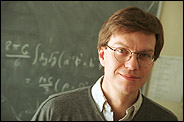Stringing together clues of the universe
Stringing together clues of the universe McGill University
User Tools (skip):
Stringing together clues of the universe
To paraphrase a certain patriotic bumpersticker, Jim Cline's Canada includes 10 dimensions.
 Physics professor Jim Cline
Physics professor Jim ClinePHOTO: Owen Egan |
|
It's not just Canada, either, but the entire universe. And no, he isn't pitching an idea for a new science-fiction movie.
The physics professor currently teaches "Physics and Psychophysics of Music" and "E&M and Optics," and is part of the High Energy Theory Group. As a particle physicist, Cline is deeply interested in "currently fashionable" ideas about the search for extra dimensions; it was on this topic that he gave a recent public lecture, presented by the McGill Society of Physics Students.
During an hour when much of the city was enjoying the primitive antics of TV's Survivor, Cline led his audience through the finer points of superstring theory, and why four dimensions just aren't good enough anymore.
The lecture began with a lighthearted slide show of Cline's recent visit to a Nordic winter school for graduate students, complete with ski-hill schematics. He next offered a few quick overheads to establish the four-dimensional universe (three spatial dimensions, plus one time dimension) that most people know and love.
Next was some quick Einstein shorthand about how "space and time get mixed up" depending on the position of the observer.
After that, things got weird.
"Sorry if the talk was a little bit technical," Cline apologized the next day. "It's hard for me to get away from my equations sometimes."
For the North American popular imagination, fueled as it is by Star Trek and X-Files imagery, ideas of extra dimensions and parallel universes aren't unheard of.
Cline admits much of his lecture bordered on the "speculative," but stresses that there are theoretical motivations for these ideas. In fact, according to superstring theory, 10 dimensions are not only possible, but essential.
Einstein searched in vain for a unifying theory of physics, trying to unite gravity and electromagnetism. Since then, however, the big challenge has been to reconcile the incompatibility of general relativity (concerning big things, like stars and galaxies) and quantum mechanics (the small, atomic end of the physics size chart).
Superstring (or, simply, string) theory may very well be that solution. As Brian Greene writes in his bestselling pop physics book, The Elegant Universe, "String theory has the potential to show that all of the wondrous happenings in the universe - from the frantic dance of subatomic quarks to the stately waltz of orbiting binary stars, from the primordial fireball of the big bang to the majestic swirl of heavenly galaxies - are reflections of one grand physical principle, one master equation."
At the centre of this "master equation," Cline explains, is the concept that instead of the long-held idea of "fundamental particles as being point-like, string theory is saying, 'No, they're not points, they're one-dimensional extended objects.' They could either be like a closed loop of string, or a little line segment."
Cline insists that, at a mathematically nitty-gritty level, string theory requires 10 dimensions in order to function. Allow for 10 dimensions, and it pretty much all works rather nicely.
This is all very exciting, but not in the science-fiction manner one might expect. Although considered fantastically large in physics terms, these extra dimensions are believed to be minuscule, somewhere between 10-35 metres and 0.3 millimetres in size.
Further, because of the huge amounts of energy that would be required to send a particle into such a dimension (in the case that it is on the smaller side of the spectrum), they do not pose any sort of danger to the average person. (Rest assured, your particles are safe.)
It is also possible that our world exists on a three-dimensional slice (or "brane") of this larger 10-dimensional universe, allowing for other brane worlds to sit on top of ours (in a manner of speaking) but the only way to interact with these dimensions, says Cline, is via gravity waves.
In other words, brane travel is out. That said, there is, however, a project in the U.S. that is basically keeping an ear cocked for gravity-wave transmissions from beyond our brane!
The sci-fi razzle-dazzle factor may be low, but this is not just a bunch of physicists navel-gazing. "There's no [everyday] application for it," Cline says, "but it's really a question of trying to understand some very deep problems in physics, and it's giving us a whole new way to look at the universe. It's a very hot topic in cosmology."
For example, Cline suggests the puzzle of "dark matter" (matter that is known to exist, but cannot be traced back to visible stars) may involve matter that is sitting on another brane, invisible to us save for its gravity waves.
That's not really something that your everyday person in the street is going to be too worried about, but it could be affecting how our universe is expanding right now.
"The things we work on might sound abstract," Cline allows. "But in a lot of these experiments, even though you can't really see the little particles, you are seeing their effect, you are seeing a representation of how they're moving in space. It's just a different way of looking at what's going on. Once you adapt to seeing things in that way, it doesn't seem abstract anymore."
Cline can, however, understand how all these fantastic-sounding ideas -- the parallel worlds sitting overtop our own, the tiny extra dimensions, the little loops of "string" -- could sound, well, just plain weird.
"Yeah," he agrees, after a thoughtful pause. "It is weird. Some of us take it for granted since it's our bread and butter, but that's also part of the reason we find it so fascinating.
"I don't think we ever completely forget that part of it. It's part of the mystique."

